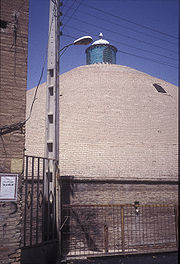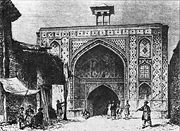
List of famous ab anbars of Qazvin
Encyclopedia

Qazvin
Qazvin is the largest city and capital of the Province of Qazvin in Iran. At the 2006 census, its population was 349,821, in 96,420 families....
is known to have had close to, or in excess of 100 drinking water reservoirs called ab anbar
Ab Anbar
An āb anbār is a traditional reservoir or cistern of drinking water in Persian antiquity. The Persian phrase literally translates as "water reservoir".-The structure:...
s before modernization in the 20th century.
Only ten remain fully intact today. All are protected as national cultural heritage relics. The extant ab anbars of Qazvin are:
- Ab anbar of Jame’ mosque
Built in 1682 (1093 AH lunar) during the reign of Shah Suleyman I Safavi, located next to the Jame’ (congregation) mosque, with the benefactor listed as Ali Khan-e Nāmi (6, 410). This ab anbar has a second private stairway that opens directly into the tank, for lay-rubi. The Sarooj covered walls are 2.4 meters thick (3, 80) surrounding all sides of the tank.
- Ab anbar of Sardar e Bozorg
Two brothers by the names of Mohammad Hasan Khan and Mohammad Hosein Qoli Khan e Sardar who were commanders of The Qajar monarch Fath-ali shah’s army make a vow to build a mosque, school, and ab anbar in the driest part of the city (3, 81) if they return victorious from a battle against the Russian army (1). This ab anbar was finished in 1812 (1227 AH lunar). Its walls are 3 m thick (3, 81).
- Ab anbar of Sardar e Kuchak
With 37 steps, 4 faucets located at various intervals, four domes, and four semi-windcatchers, this ab anbar was built in 1814 (1229 AH lunar) as part of a school-mosque-ab anbar complex by the same two brothers (3, 82).
- Ab anbar of Haj Kazem

- Ab anbar of Hakim
With 36 steps, this ab anbar was finished in 1828 (1244 AH lunar) by Haj Mirza Hakim, a local physician. Next to the sardar, a saqqa-khaneh was built at the same time. This is a small enclave where people light candles in front of sacred images of Shia icons, and pray for requests (nazr).
- Ab anbar of Mola Verdi Khan mosque
Built in 1763 (1177 AH lunar) according to the inscription on top of the sardar, during the reign of the Zand dynasty. The pasheer conatins 2 gushvars.
- Ab anbar of Zananeh Bazar
Constructed under charity by a benefactor by the name of Haj Mola Abdol-vahhab, who was a famous cleric in the Qajar era, its entry is located inside the bazaar of the coppersmiths, has 43 steps, 4 columns inside the storage tank, 10 flat domes, 5 windcatchers, and also has a separate stairway for layeh-rubi that is also connected to the basement of the adjacent mosque (3, 82).
- Ab anbar of Agha
Also a relic of the Qajar era, with 30 steps, and walls 2.2 m thick.
Dimensions and capacity
| Ab anbar name | Dimensions (m) | Capacity (m3) |
| Sardar-e Bozorg | 17 x 17 x 17 | 4900 |
| Jame’ Mosque | 37.5 x 10 x 10 | 3750 |
| Nabi Mosque | 36 x 10 x 10 | 3600 |
| Sardar-e Kuchak | 20 x 19 x 5.5 | 2090 |
| Haj Kazem | 26 x 7.5 x 10 | 1950 |
| Hakim | 18 x 18 x 6 | 1944 |
| Agha | 11.5 x 10.25 x 5.5 | 648 |
| Razavi Caravanserai | 14.5 x 6.5 x 5 | 471 |
| Zobideh Khatun | 11.5 x 2.65 x 6.5 | 198 |
See also
- Iranian architectureIranian architectureIranian architecture or Persian architecture is the architecture of Iran . It has a continuous history from at least 5000 BCE to the present, with characteristic examples distributed over a vast area from Turkey to North India and the borders of China and from the Caucasus to Zanzibar...
- Ab AnbarAb AnbarAn āb anbār is a traditional reservoir or cistern of drinking water in Persian antiquity. The Persian phrase literally translates as "water reservoir".-The structure:...
- Traditional water sources of Persian antiquityTraditional water sources of Persian antiquityMost rivers in Iran are seasonal and have traditionally not been able to supply the needs of urban settlements. Major rivers like the Arvand, Aras, Zayandeh, Sefid and Atrak were few and far between in the vast lands of Persian antiquity....

